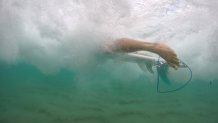Surf's up! Surfing is making its debut at the Tokyo Olympics this year and athletes from around the world will ride the waves at Tsurigasaki Surfing Beach.

Here at home in California, surfing is one of the most popular and more practiced sports. In the Bay Area, surfers can catch waves at several beaches from Pacifica and Bolinas, to Ocean Beach and of course, Santa Cruz and Mavericks in Half Moon Bay.
Don’t miss the most exciting moments of the Winter Olympics in Beijing! Sign up for our Olympics newsletter.
There are two Californians and two Hawaiian athletes you can look out for once the events kick off.
Considering this is the first time surfing will be part of this global event, there are a few things you might need to know before watching.
American Surfers in the Olympics
There are a total of four Americans among a sea of surfers in the competition. Two from Southern California and two from Honolulu.
Kolohe Andino
From San Clemente, Calif., Andino began surfing at 10-years-old and won both the ASP 6-Star Quiksilver Brazil Open of Surfing and the Vans Pier Classic world tour events in 2011.
Get a weekly recap of the latest San Francisco Bay Area housing news. Sign up for NBC Bay Area’s Housing Deconstructed newsletter.
He also won the first ever World Surf League event, the World Surf League Surf City Pro held in Huntington Beach, California.
Caroline Marks
Caroline Marks was the youngest surfer ever to qualify for the women’s Championship Tour and is now representing the USA at the Tokyo 2020 Summer Olympic Games.
She was born in Florida where she learned to surf and was constantly pushed harder by her brothers to become the best and do things out of her comfort zone.
When one of her brothers had the opportunity to move to California for work, the entire family embarked on the journey to San Clemente.
There, Caroline won NSSA titles in the girls and women’s divisions, two Vans US Open Pro Junior titles, and the ISA World Title.
John John Florence
John John Florence from Hawaii is known as "one of the most dominant pipe surfers of his era" and has won competitions such as the 2017 WSL Championship, the prestigious SURFER POLL award in 2014-2015, Vans World Cup of Surfing in 2011 and 2013 and the Quicksilver Pro France 2014 among others.
Florence's side hustle is film and has a a wide range of videos you can watch on his YouTube page below.
Carissa Moore
Carissa Moore is a four-time World Champion from Honolulu, Hawaii. She started surfing at 5-years-old alongside her father who continues to be her coach until this day.
At the age of 16, she became the youngest champion at a Triple Crown of Surfing event and won the Reef Hawaiian Pro. At the age of 18, she became the youngest person to win a surfing world title.
She has been named an Adventurer of the Year by National Geographic and Woman of the Year by Glamour magazine. In Hawaii, January 4 was declared Carissa Moore Day.
How Did Surfing Make Its Way Into the Olympics?
Let's start from the beginning. Surfing is a sport that dates back to Polynesians living in Hawaii and Tahiti, and it was popularized in the United States by Duke Kahanamoku.

Kahanamoku, known as "the father of modern surfing" won three gold medals in swimming at the Stockholm 1912 and Antwerp 1920 Games when competing for the USA.
When receiving his 1912 medal, he said his dream was to see surfing become an Olympic sport.
However, it wasn't until Aug. 3, 2016 when the International Olympic Committee approved the inclusion of the sport. It was actually only approved for the Tokyo Olympics.
Olympic Surfing Schedule
Surfing will take make its debut at Tsurigasaki Beach, about 100km away from the Olympic Stadium in Tokyo.

As for when the competition will take place, the dates are set but the times are still pending. This is due to the unpredictable nature of waves and various factors such as height, direction, strength of the wind and more.
If conditions allow, competition can be completed in just four days, but it is possible that more time will be required.
How Will the Competition be Judged?
The competition will involve 20 men and 20 women athletes competing in three rounds and three finals of 30-minute each.
The first round will include four athletes per heat and second round will include five athletes. After the third round, its a one-on-one competition.
So, what's a heat? A heat consists of two to four surfers at the same time in a pre-determined competition zone.
Each heat will consist of 30 minutes in where each surfer can catch as many waves as possible and receive a score 0-10. The catch is that only the top two waves get counted for the final score.

Because of the unpredictability of the waves, how exactly do athletes get judged? It's all based on a five-point system.
- Commitment and difficulty: This factor is the most important and judges the types, degree of difficulty, and risk of the moves performed. Additionally, because all waves are different, athletes are also judged on how high-risk the wave they have chosen is, and how committed that surfer is to maximise the potential scoring opportunities on each wave.
2. Innovation and progression: In addition to the standard manoeuvres in a surfer’s repertoire, the judges will also award points for those who push the boundaries of modern surfing with progressive moves such as aerial or tail slide variations.

3. Variety: While quality is the most important, judges are also looking out for athletes who incorporate many different types of maneuvers into their surfing.
4. Combination: This point considers how seamlessly a surfer can connect high-scoring maneuvers such as barrels, turns, and aerials on the same wave.
5. Speed, Power and Flow: This age-old surfing mantra refers to an athlete’s style on a wave, but also the subtle technical elements that separate good surfers from great ones. The ability to react to shifting conditions on a wave and maintain proper speed to perform high-scoring maneuvers, the amount of power that is going into each move so that it can be displayed at it’s highest potential, and a flow in the way that a surfer connects each move from start to finish.

Often the ultimate maneuver for surfers is the barrel, which you've probably seen in pictures before. The move is basically where a surfer disappears and rides within the hollow part of the wave.
Surfing Essentials
Have you ever wondered what surfers look for when choosing a board, wet suit or even how that made its way into the sport?
To keep it simple, surfing can be divided according to size and type of board athletes use.
The longboard is around nine feet in length and the shortboard has a pointed tip which helps with faster turns and other techniques.
Heats, Fin, Break Line, Swell? Surfing Terms You Should Know
When you're watching your favorite surfer compete, you might hear some unfamiliar terms. We got you covered. Here are some new words to add to your surfing lingo:
- Goofyfoot: A surfer who surfs right foot forward.
- Fin: Rudderlike device(s) used beneath a surfboard to assist control, direction and drive. Many different fin shapes are possible, but most are designed to resemble a dolphin's dorsal fin.

- Shortboard: A smaller, performance surfboard generally in the 5 to 7 foot range, designed for maximum speed through turns.
- Break Line: The line where waves begin to break. All things being equal, waves will begin to break when they reach water depth equaling approximately 1.3 times the wave face height.
- Set: A series of waves approaching the lineup. Waves almost always arrive in sets, and the periods in between sets are called lulls.
- Swell: Waves created further out at sea, usually by a storm.
- Choppy: Bumpy ocean and wave conditions that are rough due to strong winds and/or currents. Wind velocities are usually over 12 knots to create choppy conditions.
- Bail/bail out: To abandon or ditch one's surfboard before getting wiped out by the wave, either paddling out, or while riding the wave.
You can find more terms by checking out this Surfing 101 glossary.
How and Where to Watch
It's hard to keep up with times and dates of each competition, so we've compiled a list of livestreams for you so you can watch your favorite surfers.
Saturday, July 24
- Men's Round 1 Heats 1-5 3 p.m.
- Women's Round 1 Heats 1-5 6:20 p.m.
- Men's Round 2 Heats 1-2 9:40 p.m.
- Women's Round 2 Heats 1-2 11 p.m.
Sunday, July 25
- Women's Round 3 Heats 1-8 3 p.m.
- Men's Round 3 Heats 1-8 7:45 p.m.
Monday, July 26
- Men's Quarterfinals Heats 1-4 3 p.m.
- Women's Quarterfinals Heats 1-4 5:20 p.m.
- Men's Semifinals Heats 1-2 7:45 p.m.
- Women's Semifinals Heats 1-2 9 p.m.
Tuesday, July 27
- Men's Quarterfinals on NBC Sports Network 2:30 p.m.
- Men's and Women's Finals 4 p.m.
- Men's and Women's Finals 5:30 p.m.
Wednesday, July 28




